Introduction
Gamification has been around for long before the appearance of video games; it applies gameful designs into non-game settings to engage people in various types of activities. In the educational domain, teachers often employ games in the classroom (Kapp, 2012).
In recent days, teachers have been applying game elements into their classrooms to engage students.
The environmental problems have been a crucial issue which negatively impacted the natural ecosystem. This issue surfaced mainly due to irresponsible and selfish activities from people who did not pay much attention to safeguard and protect their environment (Becker, 2014).
Aim and Objective(s)
The purpose of this pilot study is to examine the recycling intention among participants after experiencing an educational recycling with a crafting activity named as Edcraft Gamified Learning (EGL) sessions.
This research aimed to test game elements which are related to the self-determination theory that can improve the recycling intention, with attitude, subjective norm and perceive behavioural control as a mediator. The objective is to develop a gamified learning framework that can engage recycling intention learning and to understand the effectiveness of the gamification framework.
Related Studies
Gamification and learning
A recent study conducted by Bai (2020) showed that gamification is an effective way to quantify participants’ academic performance, which leads to learning experience and engagement. Although gamification in learning is a broad area to research, it is still conclusive (Van, 2018), especially on the implementation of gamified design learning on learners’ motivation. Besides, game-based design or serious game has been a famous implementation among the educators nowadays (Van, 2018). This has led to the motivation of conducting this research with the larger aim to examine the (gamers’) learners’ experiences, thoughts and reflections about their learning based on gamified approaches. In gamification, badges and leaderboards are often implemented into a non-game context (Deterding, Dixon, Khaled & Nacke, 2011) and the most prominent examples are Duolingo for language learning, Codeacademy and CodeCombat for computer programming learning. Using games in education has shown its success in the educational environment (de-Marcos, Domínguez, Saenz-de-Navarrete & Pages, 2014). The freedom to retry has allowed the students to experiment freely without the fear of failing, and this has improved their engagement in the learning process (Lee & Hammer, 2011).
Self Determination Theory (SDT)
Self-Determination Theory (Ryan & Deci, 2009) is used as a theoretical support to enable a better understanding of the gamification mechanics in the context of motivating participants to learn. Besides, it is a theoretical perspective that explains the human behavior and performance (Ryan & Deci, 2009). The application of this theory into learning design is important in order to better design or control the relationship between gamification and learning behaviours and outcomes.
An educational research by Barna (2017) mentioned that “gamification research often focuses specifically on participants’ performance like grades also in IT courses” (Barna & Fodor, 2017), or on behavioural outcomes like tasks on schedule.

Figure 1: A simple spectrum of self-determination and motivation. Adapted from (Scruggs, Beveridge & Clocksin, 2005) and (Deci, Vallerand & Pelletier, 1991).
Autonomous and Controlled Motivation
Few studies from Turel (2016) have confirmed that SDT constructs and predicts the future intention. The current work builds upon previous research by (Turel, 2016), who promoted that by “incorporating a measure of Autonomous Motivation (AM) and Controlled Motivation (CM) intended to clarify the exact revelators of behavioral intention”.
AM is a self-determined behavior. It works as an intrinsic oriented goal and is defined as a behavior that engages with intrinsic goals or outcomes and discoveries of a self-behaviour from an individual (Deci & Ryan, 1985).
With AM intact, a sense of choice can be felt by the individuals, as well as self-recognition, interest and satisfaction. Therefore, the behavior of a task is more likely to persist. Individuals are personally motivated by the need to feel self-driven without external factors and autonomous reasons or actions (Deci & Ryan, 1985).
CM also engages individual’s behaviors for extrinsically motivated elements such as rewards, in forms of money, consumable credits, points or perceived approval from others or to avoid any external penalisation and guiltiness (Deci & Ryan, 1985).
The engagement of individuals in the behavior for “controlled reasons often has a sense of restriction and pressure when engaging such behavior”, and they are only motivated when engaging with the external factor (Deci & Ryan, 1985).
If the external reinforcing agent is removed, the task will not be performed. Individuals who are control-motivated are less self-regulated. AM and CM will lead to intrinsic and extrinsic motivation that will eventually be the determinant of the intention of recycling. However, numerous researches on the recycling behaviour have been carried out using The Theory of Planned Behaviour (TPB) (Boldero, 1995; Chan, 1998; Cheung et al., 1999). Therefore, the three most important components; attitude, subjective norm and perceived behavioural control have been incorporated into this research as a mediator.
Intrinsic Motivation
In the SDT model, enjoyment, challenge, pleasure and interest are the intrinsic motivation factors that can engage performance or behaviour.
Ryan and Deci (2000) define the intrinsic motivation as “an activity that characterizes its inner satisfaction rather than other external outcomes”. It is not affected by other external stimulations, pressure or rewards to get intrinsically motivated, challenged and engaged.
Intrinsic motivation facilitates “the behavioral regulation representing the engagement in an activity for the sheer pleasure and satisfaction” (Ryan & Deci, 2000). Moreover, a behavior driven by intrinsic motivation is closely related to the “enjoyment, engagement in a task, or the capacity of the task to provide opportunities for cognitive and social development” based on Deci & Ryan’s (2002) study.
It is perceived that some individuals were not engaging themselves into a particular activity because they did not enjoy the activity. Boosting up the inner motivation or intrinsic motivation could eliminate this attitude. With any external rewards, players enjoy the activity and get more excited about the assigned task, and therefore, they will keep being engaged in performing the activity.
Extrinsic Motivation
Extrinsic motivation is more apparent in the reward and achievement context. Extrinsic motivation can be in the form of grades, a promotion and social reciprocity. This type of motivation is not necessarily rewarding in a physical way.
In real-life practice, the applications of gamification are not an intention or extreme video games. Intrinsically motivating game-like experiences are most widely accepted explanations for the behavioral impact from gamification elements, for example, leaderboard, badges and points (Deci, Vallerand & Pelletier, 1991; Hamari & Koivisto, 2014). That will be included in the current study.
By providing a suitable push factor by an extrinsic motivation, it is perceived that a reasonable performance and a goal can be achieved within a period.
Amotivation
Lim & Wang (2009) explain that amotivation is a form of motivation that does not involve personal feelings. Amotivation is the lack of interest, enthusiasm, emotion, or concern towards an action. It is more closely related to goal-directed behaviours (Deci & Ryan, 2002). In a study by (Scruggs, Beveridge and Clocksin, 2005), they found that amotivation predicted students’ physical activity intention; it shows the strong relationship between Amotivation and intention.
At the end of the opposite side of motivation, is amotivation, which is a state where the engagement of an activity is not regulated by intention or intrinsic motivation. It is an opposite behavioral regulation, displaying the engagement in an activity with the ignorance of pleasure and satisfaction (Ryan & Deci, 2000)
The Theory of Planned Behavior (TPB)
The TPB by Ajzen (1991) stated that “each behavior is positively influenced by a behavioural intention that will be predicted by attitudes (i. e., preferences beliefs), subjective norms (i. e., perceptions that others would approve), and perceived behavioural control (PBC) (i. e., difficulty to perform a particular behaviour)”.The three main above mentioned components from the theory are the mediator to investigate the recycling intention among EGL participants.
Research Conception Framework and Edcraft Gamified Learning (EGL) Gamification Design
This study’s main objective is to study the intention of recycling, and it is referred to as “an individual’s self-commitment to engage in recycling behaviors” (Park & Ha, 2014). According to a study conducted by (Park, 2014), “recycling intention has been seen by drawing variables and models from social psychology”. The Theory of Planned Behavior (TPB) proposed by Ajzen is the main theory used to study the intention of recycling. Numerous researches from TPB have also shown the improvement of the recycling of E-wastes. This proves the effectiveness of TPB in recycling and learning.
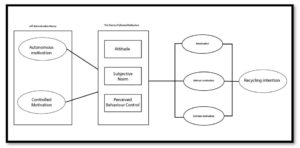
Figure 2: Research conceptual framework
The main idea of the research model (Figure 2) is to achieve recycling intention by the end of the EGL activity. This research framework adopts SDT and TPB into the EGL gamification design for a recycling learning activity, where SDT is used to study the motivation for the gamification design. SDT is an important theory to investigate in numerous gamification researches. It is based on the spectrum of self-determination, and categorised from autonomous motivation to controlled motivation and to amotivation as explained in Section II – Related studies. The keywords of the SDT spectrum are selected to match this study such as pleasure, fun, enjoyment and satisfaction for intrinsic motivation, and value, competition, reward and control for extrinsic motivation.
TPB is widely used for recycling the related behavioural theory to test the attitude, social norm and perceived behavioural control that affect the intention of recycling.
Study Design and Flow of EGL Pilot Study
EGL activities were conducted in two piloted sessions. The first session was piloted to young participants and the second session was piloted to elder participants, in a “level 1 & level 2” gamified class setting. Before starting the game, the participants were required to answer a pre-survey, then followed by watching a video about the objective of EGL with footage of the current waste problems.
Next, the participants watched a tutorial video that guided them to make a “level 1 craft” out of unused plastic. The participants were given 2 hours to make their own crafts according to the tutorial video. During the session, they were also guided by mentors. Once the first level was done, participants were ranked by judges, and proceeded to level 2. In this level, they replicated the process of crafting by creating a more difficult and challenging craft. After “level 2” craft creation, the participants were asked to fill in a post-survey questionnaire. The participants were then ranked by the appointed judges, and the winners earned beautiful badges as a reward. As for the data collection, the pre and post survey consisted of five-point Likert scales of “strongly agree, agree, neutral, disagree and strongly disagree” given to the participants in paper form during the EGL activity. The pre-survey questionnaire is given right before the activity started, as it is the state when they have little to no impression about the activity, while the post-survey questionnaire is given right after the activity, completing the EGL experience.
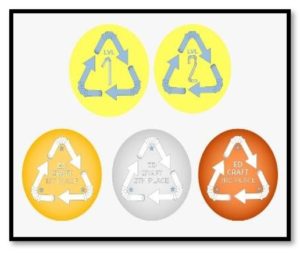
Figure 3: Badges for the winners as a reward.
Descriptions of The Study, Data Analysis and Findings
Participants
There were 14 participants involved in the two piloted EGL sessions. First, EGL has six college students between 19 to 29 years old and the second session involved eight elderly persons aged between 50 to 60 years old. The questionnaire surveys consist of four major aspects, namely the recycling awareness, SDT, gamification, TPB on “attitude, subjective norm, perceived behavioural control and intention to recycle”. Overall, all the 14 participants answered the survey items, and the dependent variable examines their intention to recycle.
Data collection
Pre-survey is a prior survey before EGL. It is compared to the Post-survey data in terms of the results, specifically before and after the intention to recycle. In the first EGL, a competition was held where level 1 and level 2 crafts were made for the participants to follow.
Post Survey is a survey given after the participants completed the EGL intervention.
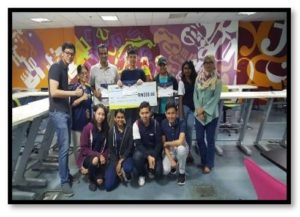
Figure 2: The first pilot study session with six participants aged between 19- 29.
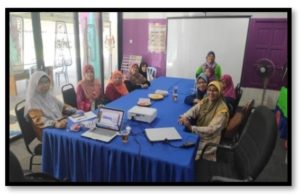
Figure 3: The second pilot study session with eight participants aged between 50- 65
To determine the differences between the pre-survey and the post-survey, Wilcoxon signed rank test was used as a hypothesis testing tool, allowing the test to acquire an assumption from the test object population. Wilcoxon signed rank test compares the two independent groups’ means to find out whether there is statistical evidence that the related population means are significantly different. Wilcoxon signed rank test is a non-parametric test.
Analysis and Findings
A paired t-test and Wilcoxon signed rank test are normally used when a survey is conducted twice (pre and post survey) to the same group of participants. The paired t-test can show whether the mean (average) of Dependent Variable (versus the grouping variable) has changed between the first and second time the participants took the survey. As a small part of the above framework displayed in Figure 2, this analysis only tests the recycling intention itself based on before and after the activity. The relationships between other independent variables and mediators will be tackled in the actual EGL activity.
Since the current study involved a small piloted sample size for EGL, therefore it is not advisable to run the normality test for a small sample size; the parametric test such as the paired t-test is inappropriate in this context. Instead, the authors decided to use the equivalent non-parametric test, namely the Wilcoxon signed-rank test to compare two sets of scores from the 14 samples.
Table 1: EGL pre and post survey on “intention to recycle” based on “Wilcoxon signed-rank test”.
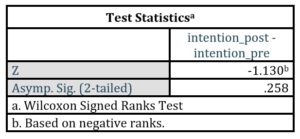
According to the data, after the EGL class, there were two participants with lesser intention in recycling (recorded through the data), while seven participants have recorded a positive intention to recycle, and five participants have recorded no changes in their intention to recycle upon completing EGL. This could be due to the fact that EGL steps are still shallow and insufficient in-depth study, and details are included to strengthen the activity flow.
Table 2: EGL Wilcoxon test statistics
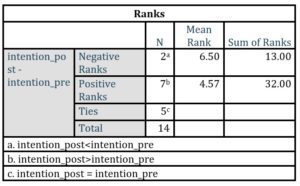
Table 2 shows the “Asymp. Sig (2-tailed)” value, in which the “p value”> .05 for the null hypothesis test of “equivalence of means for pre and post survey on ‘Intention to recycling’”; the hypothesis alternative is “There are differences for both pre and post survey on the intention for recycling”. The result can be interpreted as non-significant for the Wilcoxon signed-rank test, which means that the hypothesis null cannot be rejected, and hence, there is no difference of the “Intention to recycle” after completing their EGL classes with two levels of a crafting game.
Discussions, Conclusion and Future Work
This is a pilot study of the EGL that will be further expanded with more samples of actual study by considering more gamified learning design requirements surfaced through the pilot study. Important precaution measures should include: coaching the participants whenever they are in trouble to avoid drop out; the difficulty level of the craft activity should be suitable for novice with no much pressure on the participants; and the activity should be conducted during the participants’ leisure time to avoid drop out or lack of concentration and interest in the activity. Besides, to further improve the experience of EGL, evaluation rules and a grading rubric system are to be consolidated for the judges to add value and gauge the participants’ works in a more systematic manner. Participants should be able to further express their creativity with a wide range of crafts in each level and not to limit their creativity in their gamified works.
Results of the intention (to recycle) for pre and post survey of the EGL activity shows no difference based on the analysis, mainly because the precaution measures and EGL content weren’t well established for this pilot test activity.. In the future study, a better EGL ecosystem is expected to be equipped with a more established EGL content, organised in a borderless online platform with participants/learners able to view each other’s works/crafting results and rankings via a live leaderboard. It is believed that EGL could produce a positive result in the actual study with the improvement in EGL activity content, precaution measures and procedures, as mentioned.
(adsbygoogle = window.adsbygoogle || []).push({});
References
- Abramovich, S., Schunn, C., & Higashi, R. M. (2013). Are badges useful in education? It depends upon the type of badge and expertise of learner.EducationalTechnology Research & Development, 61(2), 217–232.
- Ajzen, I., 1991. The theory of planned behavior. Organ. Behav. Hum. Decis. Process. 50(2), 179–211
- Bai, S., Hew, K. F., & Huang, B. (2020). Does gamification improve student learning outcome? Evidence from a meta-analysis and synthesis of qualitative data in educational contexts. Educational Research Review, 30(December 2019), 100322. https://doi.org/10.1016/j.edurev.2020.100322
- Barna, B., & Fodor, S. (2017). An empirical study on the use of gamification on IT courses at higher education. Teaching and learning in a digital world (pp. 684–692). Cham: Springer. https://doi.org/10.1007/978-3-319-73210-7_80.
- Boldero, J. (1995). The prediction of household recycling of newspapers; the role of attitudes intentions and situational Journal of Applied Social Psychology, 25, 440–62.
- Becker, P., (2014). Our Disturbances, Disruptions and Disasters in a Dynamic World. InSustainability Science: Managing Risk and Resilience for Sustainable Development.pp. 57–119.
- Buckley, P., & Doyle, E. (2014). Gamification and student motivation.Interactive Learning Environments, 22(6), 1–14.
- Chan, K. (1998). Mass communication and pro-environmental behaviour: Waste recycling in Hong Kong. Journal Environmental Management, 52, 317–25.
- Cheung, S., Chan, D., & Wong, Z. (1999). Re-examining the theory of planned behaviour in understanding waste paper recycling. Environmental Behavior, 31, 587–617.
- de-Marcos, L., Domínguez, A., Saenz-de-Navarrete, J., & Pages, C. (2014). An empirical study comparing gamification and social networking on e-learning. Computers & Education, 75,82e91
- Deci, E. L., & Ryan, R. M. (1985). The general causality orientations scale: Self-determination in personality. Journal of Research in Personality, 19, 109–134. doi:10.1016/0092-6566(85)90023-6
- Deci, E. L., & Ryan, R. M. (1985). Intrinsic motivation and self-determination in human behavior. New York, NY: Plenum Press.
- Deci E. L., Vallerand R., Pelletier L., et al. (1991) Motivation and education: the self-determination perspective.Educational Psychologist 26(3): 325–346.
- Deci, E. L., & Ryan, R. M. (2000). The “what” and “why” of goal pursuits: Human needs and the self-determination of behavior.
- Deci, E. L., & Ryan, R. M. (2002). Handbook of self-determination research. Rochester:University Rochester Press.
- Deterding, S., Dixon, D., Khaled, R., &Nacke, L. (2011). From game design elements to gamefulness: Defining“gamification.Proceedings of the 15th international academic MindTrek conference: Envisioning future media environments(pp. 9–15). New York, NY, USA: ACM.
- Djaouti, D., Alvarez, J., &Jessel, J. P. (2011). Classifying serious games: The G/P/S model. In P. Felicia (Ed.), Handbook of research on improving learning and motivation through educational games: Multidisciplinary approaches (pp. 118–136). Hershey, PA: IGI Global.
- Fishbein, M., &Ajzen, I. (1975). Belief, attitude,. Intention and behavior: An introduction totheory and research. Reading, MA: Addison-Wesley.
- Hagger, M. S., Hardcastle, S. J., Chater, A., Mallett, C., Pal, S., &Chatzisarantis, N. L. D. (2014). Autonomous and controlled motivational regulations for multiple health-related behaviors: between- and within-participants analyses. Health Psychology and Behavioral Medicine, 2(1), 565–601. https://doi.org/10.1080/21642850.2014.912945
- Hamari, J., &Koivisto, J. (2014). Measuring flow in gamification: Dispositional flowscale-2. Computers in Human Behavior, 40, 133–143.
- Kapp, K. M. (2012). The gamification of learning and instruction: Game-based methods and strategies for training and education. San Francisco, CA: Pfieffer.
- Lee, J. J., & Hammer, J. (2011). Gamification in education: what, how, why bother? Academic Exchange Quarterly, 15(2), 146. Retrieved fromhttp://dialnet.unirioja.es/servlet/ articulocodigo3714308
- Lim, B. S. C., & Wang, C. K. J. (2009). Perceived autonomy support, behavioural regulations in physical education and physical activity intention. Psychology of Sport & Exercise, 10(1), 52–60.https://doi.org/10.1016/j.psychsport.2008.06.003
- Marin, R. S. (1990). Differential diagnosis and classification of apathy. The American Journal of Psychiatry, 147, 22–30.
- Psychological Inquiry, 11, 227–268. doi:10.1207/S15327965PLI1104_01
- Park, J., & Ha, S. (2014). Understanding consumer recycling behavior: Combining the theory of planned behavior and the norm activation model. Family and Con- sumer Sciences Research Journal, 42(3), 278e291.
- Ryan, R. M., & Deci, E. L. (2009). Promoting self-determined school engagement: Motivation, learning, and well-being. In K. Wentzel, A. Wigfield, & D. Miele (Eds.).Handbook of motivation at school (pp. 171–196). New York, NY, USA: Routledge.
- Ryan, R. M., & Deci, E. L. (2000). Self-determination theory and the facilitation of motivation, social development, and well-being.American Psychologist,55,68e78.
- Scruggs P. W., Beveridge S. K., and Clocksin B. D., (2005) Triaxial accelerometry and heart rate telemetry: relation and agreement with behavioural observation in elementary physical education.Measurement in Physical Education and Exercise Science 9(4): 203–218
- Turel, O. (2016). Untangling the complex role of guilt in rational decisions to discontinue the use of a hedonic Information System. European Journal of Information Systems, 25(5), 432e447.
- Van Roy, R., & Zaman, B. (2018). Need-supporting gamification in education: An assessment of motivational effects over time. Computers and Education, 127(August), 283–297. https://doi.org/10.1016/j.compedu.2018.08.018
- Zumbach, J., Rammerstorfer, L., &Deibl, I. (2020). Cognitive and metacognitive support in learning with a serious game about demographic change. Computers in Human Behavior, 103(August 2019), 120–129.https://doi.org/10.1016/j.chb.2019.09.026









